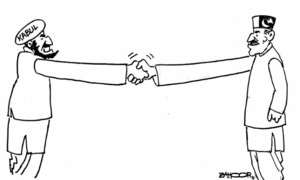THANKS to Aamir Khan, the issue of India’s skewed sex ratio is making headlines again. In the debut of Satyamev Jayate — his take on Oprah Winfrey’s iconic issue-based talk show — the Bollywood star emphasised the fact that one million girls are prevented from being born in India each year.
Through a series of interviews, diatribes and documentaries, he made the point that rampant sex selection, son preference and female foeticide were creating a huge demographic challenge in India.
According to 2011 census data from India, the sex ratio for children under the age of six is 914 girls to 1,000 boys. The female numbers have registered a decline since 2001, when the sex ratio was 927 girls to 1,000 boys. Lest we look across the border and feel complacent, we should realise that social scientists predict a similar problem could loom in Pakistan in coming decades.
The current male-to-female ratio in the total Pakistani population is 1.06. This imbalance is explained by academics as a consequence of widespread discriminatory behaviour against women: girls are underfed and remain malnourished from birth, they are denied the same healthcare that their brothers receive, and they fall victim to Pakistan’s dangerously high maternal mortality rate.
But social scientists are beginning to detect a trend of sex-selective practices at birth in Pakistan as well. They argue that the naturally high mortality rate for infant boys, high rates of migration and widespread violence, which targets young men more frequently than women, should offset the male-female imbalance. The fact the imbalance persists implies another factor at work. (Pakistan’s overdue census has prevented proper statistical analysis of sex ratios at birth.)
This is not to say that the practice of sex selection is widespread in Pakistan. Social scientists have found that Islamic injunctions against abortion have made the practice less common in some (but not all) Muslim countries. But new reports out of India suggest that Pakistan — like other countries where there is a strong societal son preference — could be vulnerable to a sharp increase in sex selection at birth, despite the religious context.
A new analysis of 2001 Indian census data found that Indian Muslims had better male-to-female sex ratios than the overall population, particularly upper-caste Hindus, despite their lower socio-economic status (generally, sex selection is more common among lower social strata). The sex ratio of Hindus was 931 girls to 1,000 boys, while among Muslims it was 936 girls to 1,000 boys. Rather than peg this difference on religion, social scientists dug through more data and found that markedly higher fertility rates among Indian Muslims resulted in a lower frequency of sex-selective practices.
The reasoning here is obvious: in societies that value sons more than daughters, a family that chooses to have only one or two children is more likely to resort to female foeticide — or even infanticide — to ensure that those children are boys.
Indeed, social scientists studying sex selection in China agree that declining fertility rates are the most important factor behind the spread of female foeticide and other sex-selective practices.
It is this aspect of sex selection that makes Pakistan vulnerable to the practice. Despite the best efforts of the mullahs, Pakistan (or at least huge swathes of the country) is likely to register declining fertility rates in coming years. The worsening economy will drive more women into the workplace, albeit against their family’s wishes. Rapid urbanisation will bring more women closer to various means of contraception. And increases in female literacy will lead to better birth spacing.
The downside in a country where baby boys are feted with rounds of aerial fire while baby girls are met with tears is that as women start having smaller families, they are likely to engage in sex-selective practices. This engagement will be facilitated by the fact that Pakistan’s medical industry is poorly regulated and corrupt. Research in other Asian countries has found that the increasing availability of technologies that enable sex selection spur the practice. It is easy to see how, in the absence of robust regulation, the screening procedures that make sex selection possible will spread across Pakistan in response to growing public demand.
Given this knowledge of trends in sex selection across the region, Pakistan is well positioned to dodge the problem in the future. And no — the answer is not to allow fertility rates to remain as high as they are. The best way to discourage sex selection at birth is to diminish son preference by promoting socioeconomic development — specifically female employment —– so that daughters are viewed as blessings not burdens. Better government regulation of the health sector is also a must.
Given the societal impact of a skewed sex ratio, the incentives to nip the problem of sex selection at birth are high. In societies where men outnumber women, gender discrimination against females is perpetuated, partly because the shortage of women in a particular age bracket compels men to marry significantly younger women.
In India, China and other Asian countries where sex selection at birth is common, disruptions in the marriage market have led to increases in human trafficking and bride sales. Since young men are more likely to engage in violent behaviour, these societies have also seen spikes in crime and other public disorder.
In Pakistan, growing numbers of unmarried men would result in an even greater incidence of sexual violence. Moreover, unmarried men without familial responsibilities would be the perfect recruits for extremist organisations looking for suicide bombers with nothing to lose.
Rather than addressing the social fallout of a skewed sex ratio, Pakistan is better off learning from the mistakes of the region and avoiding the problem in the first place.
The writer is a freelance journalist.
huma.yusuf@gmail.com
Twitter: @humayusuf








































